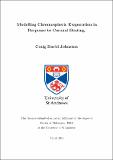Files in this item
Modelling chromospheric evaporation in response to coronal heating
Item metadata
| dc.contributor.advisor | Hood, Alan W. | |
| dc.contributor.advisor | De Moortel, Ineke | |
| dc.contributor.author | Johnston, Craig David | |
| dc.coverage.spatial | 184 p. | en_US |
| dc.date.accessioned | 2018-06-26T15:09:38Z | |
| dc.date.available | 2018-06-26T15:09:38Z | |
| dc.date.issued | 2018-06-26 | |
| dc.identifier.uri | https://hdl.handle.net/10023/14630 | |
| dc.description.abstract | This thesis presents a new computationally efficient method for modelling the response of the solar corona to the release of energy. During impulsive heating events, the coronal temperature increases which leads to a downward heat flux into the transition region (TR). The plasma is unable to radiate this excess conductive heating and so the gas pressure increases locally. The resulting pressure gradient drives an upflow of dense material, creating an increase in the coronal density. This density increase is often called chromospheric evaporation. A process which is highly sensitive to the TR resolution in numerical simulations. If the resolution is not adequate, then the downward heat flux jumps over the TR and deposits the heat in the chromosphere, where it is radiated away. The outcome is that with an under-resolved TR, major errors occur in simulating the coronal density evolution. We address this problem by treating the lower transition region as a discontinuity that responds to changing coronal conditions through the imposition of a jump condition that is derived from an integrated form of energy conservation. In this thesis, it is shown that this method permits fast and accurate numerical solutions in both one-dimensional and multi-dimensional simulations. By modelling the TR with this appropriate jump condition, we remove the influence of poor numerical resolution and obtain the correct evaporative response to coronal heating, even when using resolutions that are compatible with multi-dimensional magnetohydrodynamic simulations. | en_US |
| dc.language.iso | en | en_US |
| dc.publisher | University of St Andrews | |
| dc.relation | C. D. Johnston, A. W. Hood, P. J. Cargill, and I. De Moortel. A new approach for modelling chromospheric evaporation in response to enhanced coronal heating. I. The method. A&A, 597:A81, January 2017a. doi: 10.1051/0004-6361/201629153. | en_US |
| dc.relation | C. D. Johnston, A. W. Hood, P. J. Cargill, and I. De Moortel. A new approach for modelling chromospheric evaporation in response to enhanced coronal heating. II. Non- uniform heating. A&A, 605:A8, August 2017b. doi: 10.1051/0004-6361/201730486. | en_US |
| dc.rights | Attribution 4.0 International | * |
| dc.rights.uri | http://creativecommons.org/licenses/by/4.0/ | * |
| dc.subject | Sun: corona | en_US |
| dc.subject | Sun: magnetic fields | en_US |
| dc.subject | Magnetohydrodynamics (MHD) | en_US |
| dc.subject | Coronal heating | en_US |
| dc.subject | Chromospheric evaporation | en_US |
| dc.subject.lcc | QB529.J7 | |
| dc.subject.lcsh | Sun--Corona--Mathematical models | en |
| dc.subject.lcsh | Solar chromosphere | en |
| dc.title | Modelling chromospheric evaporation in response to coronal heating | en_US |
| dc.type | Thesis | en_US |
| dc.contributor.sponsor | Carnegie Trust for the Universities of Scotland | en_US |
| dc.type.qualificationlevel | Doctoral | en_US |
| dc.type.qualificationname | PhD Doctor of Philosophy | en_US |
| dc.publisher.institution | The University of St Andrews | en_US |
| dc.publisher.department | University of St Andrews. Solar & Magnetospheric Theory Group | en_US |
The following licence files are associated with this item:
This item appears in the following Collection(s)
Except where otherwise noted within the work, this item's licence for re-use is described as Attribution 4.0 International
Items in the St Andrews Research Repository are protected by copyright, with all rights reserved, unless otherwise indicated.


